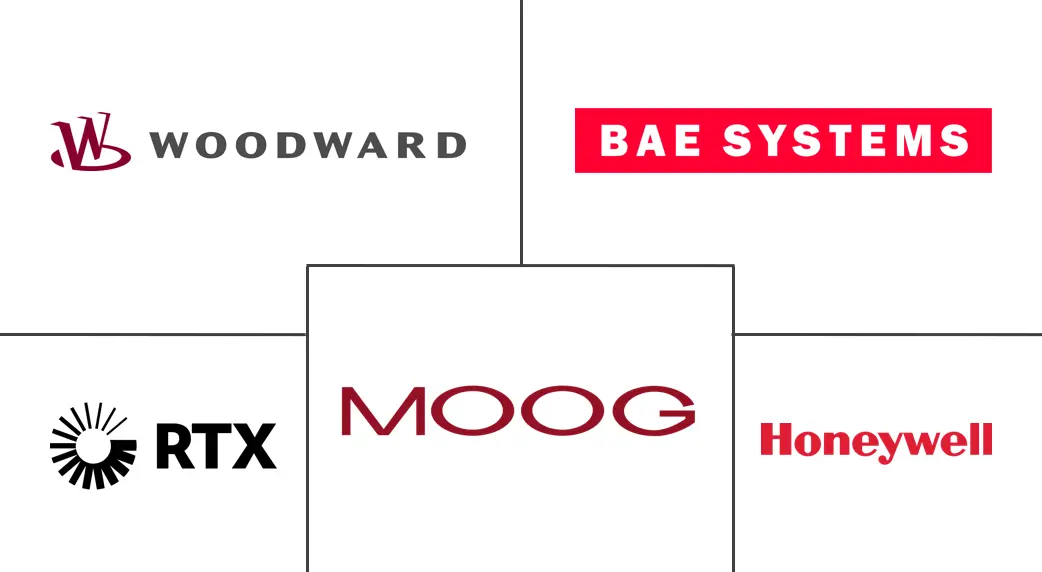Thrust Vector Control Market Size and Share
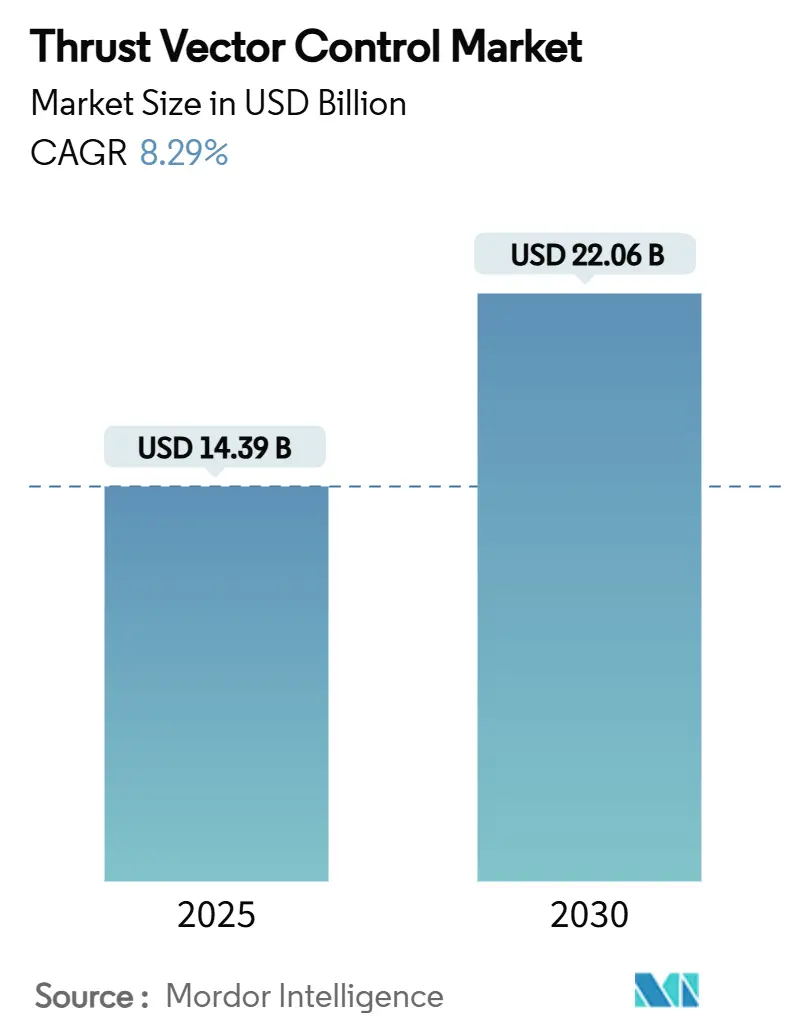
Thrust Vector Control Market Analysis by Mordor Intelligence
The thrust vector control market size is estimated at USD 14.39 billion in 2025 and is on track to reach USD 22.06 billion by 2030, charting a strong 8.92% CAGR. Sustained defense-modernization programs, the steady climb in small-satellite launch cadence, and the reopening of orbital access for private crewed missions are widening the customer base at a pace unseen a decade ago. Program managers in the United States, Japan, and India are overhauling missile inventories to add hypersonic and very-long-range standoff weapons that can out-maneuver interceptors. This mission profile depends on precise, high-authority in-flight vectoring. Reusable heavy-lift launch vehicles such as Falcon Heavy and Blue Origin’s New Glenn subject every gimbal, flex nozzle, and electromechanical actuator to 10 to 20 times the thermal-mechanical duty cycles seen in expendable systems, enlarging the aftermarket pool and elevating reliability requirements. At the same time, the rapid replacement of hydraulic actuation with all-electric designs removes entire subsystems of pumps and plumbing but lifts early-phase qualification costs. Export-control reforms in the United States streamline licensing for space-tourism hardware. Yet, dual-use propulsion items now sit under tighter thresholds, creating an uneven landscape that global suppliers must navigate.
Key Report Takeaways
- By application, launch vehicles led with 49.87% of the thrust vector control systems market share in 2024; satellites are forecasted to expand at a 10.68% CAGR to 2030.
- By end user, the defense segment held 65.78% of the thrust vector control systems market share in 2024, while space agencies recorded the fastest projected CAGR at 10.07% through 2030.
- By technology, gimbal nozzle systems accounted for 42.65% of total revenue in 2024, and rotating nozzles are advancing at an 11.87% CAGR through 2030, underscoring a pivot toward high-agility designs.
- By geography, North America contributed 47.30% of 2024 revenue; Asia-Pacific is expected to record the strongest 9.87% CAGR through 2030, driven by indigenous launch and defense initiatives.
Global Thrust Vector Control Market Trends and Insights
Drivers Impact Analysis
| Driver | (~) % Impact on CAGR Forecast | Geographic Relevance | Impact Timeline |
|---|---|---|---|
| Rising launch-vehicle cadence and small-sat demand | +2.1% | Global, concentrated in North America and Asia-Pacific | Medium term (2-4 years) |
| Missile fleet modernization in major defense budgets | +1.8% | North America, Europe, Asia-Pacific | Long term (≥ 4 years) |
| Reusable rockets amplifying TVC maintenance cycles | +1.4% | North America, spill-over to Europe and Asia-Pacific | Short term (≤ 2 years) |
| Hypersonic weapons race among the US, China, and Russia | +1.2% | North America, Asia-Pacific, Europe | Long term (≥ 4 years) |
| Commercial space-tourism and private crewed-mission boom | +0.9% | North America, early expansion to Europe | Medium term (2-4 years) |
| Transition from hydraulic to all-electric actuators | +0.8% | Global | Medium term (2-4 years) |
| Source: Mordor Intelligence | |||
Rising launch-vehicle cadence and small-sat demand
Starlink’s more than 7,000 operational units fleet confirms that multi-plane constellations are no longer a theoretical growth vector. As network owners plan another 411 commercial constellations, launch providers are forced to fly every two to three days, a tempo that exposes thrust-vector assemblies to repeated thermal shocks and acoustic loads. Patent filings in space propulsion have climbed 9% annually for 20 years, pointing to a technology refresh cycle that rewards suppliers offering common-core modules adaptable across multiple vehicle classes.[1]Source: European Patent Office, “Propulsion Systems for Space – Patent Insight Report,” epo.org Standardization lowers integration cost, simplifies spares pooling, and compresses vehicle refurbishment timelines—factors that directly shape buying decisions at emerging micro-launcher firms.
Missile fleet modernization in major defense budgets
The FY 2025 Pacific Deterrence Initiative sets aside USD 9.9 billion for standoff and missile-defense programs reliant on agile vectoring during boost, mid-course, and terminal phases. Japan’s JPY 970 billion (USD 6.74 million) commitment to hypersonic glide vehicles and India’s accelerated interceptor roadmap bring similar pull-through to regional suppliers. Designers must qualify actuators across –65°C stratospheric climbs and greater than 3,000°C re-entry peaks, which stretches test-article queues and keeps order books full for years. Electro-mechanical gimbals, although costlier up front, are preferred for their almost instantaneous step response and built-in health monitoring.
Reusable rockets amplifying TVC maintenance cycles
Falcon Heavy center engines already exceed 20 flights per gimbal, upending the old expendable cost-of-ownership model. United Launch Alliance’s Vulcan pairs heritage hydraulics with modular seals designed for ten reflights, while China’s SAST demonstrator points to a truly global shift toward recovery architectures. In this high-reuse context, the thrust vector control market looks like the aircraft APU aftermarket—margins accrue less from the original ship-set and more from refurbishment kits, software updates, and fast-turn exchange pools.
Hypersonic weapons race among US–China–Russia
Hudson Institute modeling shows that above Mach 5, an interceptor has only milliseconds to adjust course, meaning evasive payloads must blend aero-fin input with high-authority vectoring.[2]Source: Richard Weitz, “Countering Emerging Russian and Chinese Hypersonic Threats,” Hudson Institute, hudson.org Prototype missiles rely on rotating nozzles and actively cooled throat liners that tolerate 3,500°C gas streams. This pushes demand for nickel-based super-alloys and high-conductivity carbon-carbon materials, which are produced in limited volumes and require dual-path qualification for military use.
Restraints Impact Analysis
| Restraint | (~) % Impact on CAGR Forecast | Geographic Relevance | Impact Timeline |
|---|---|---|---|
| High qualification and certification cost | -1.6% | Global | Long term (≥ 4 years) |
| Stringent reliability/safety thresholds in human-rated flight | -1.2% | Global, concentrated in North America and Europe | Medium term (2-4 years) |
| Supply bottlenecks in high-temperature composite nozzles | -0.9% | Global, acute in Asia-Pacific | Short term (≤ 2 years) |
| Tightening export-control regimes on dual-use propulsion tech | -0.7% | Global, US-China trade corridors | Medium term (2-4 yea |
| Source: Mordor Intelligence | |||
High qualification and certification cost
FAA System Safety Assessments require multi-axis vibration, cryogenic shock, and EMI immunity tests, often pushing early-stage spending north of USD 10 million.[3]Source: Daniel Leach, “System Safety Assessments Final Rule Regulatory Impact Analysis,” Federal Aviation Administration, regulations.gov Cash-strapped start-ups must therefore partner with primes or surrender programs, reinforcing incumbent strongholds within the thrust vector control systems market.
Stringent reliability/safety thresholds in human-rated flight
Commercial crew vehicles treat any single-point failure in vectoring as potentially crew-fatal. Engineers deploy pseudo-inverse control algorithms that re-allocate thrust among remaining engines within milliseconds. The extra code scrutiny and redundant sensors add cost and lengthen the schedule, but remain non-negotiable for crewed certifications.
Segment Analysis
Launch vehicles captured 49.87% of 2024 revenue, reflecting routine Falcon 9 reflights, Ariane 6 ramp-up, and China’s Long March cadence. Satellites, however, are expected to post a 10.68% CAGR through 2030 as operators retrofit electric thrusters with micro-gimbals for collision avoidance..
Reusable architectures expose each gimbal to dozens of flight cycles, so operators prize hot-swap cartridges that cut turnaround to under 36 hours. At the other end of the spectrum, nano-launchers need off-the-shelf electromechanical gimbals that integrate with COTS avionics, compressing design timelines to months rather than years. This polarity forces suppliers to maintain two distinct roadmaps: high-load legacy actuators for heavy-lift cores and compact, lightweight units for micro-launchers and satellite kick stages.
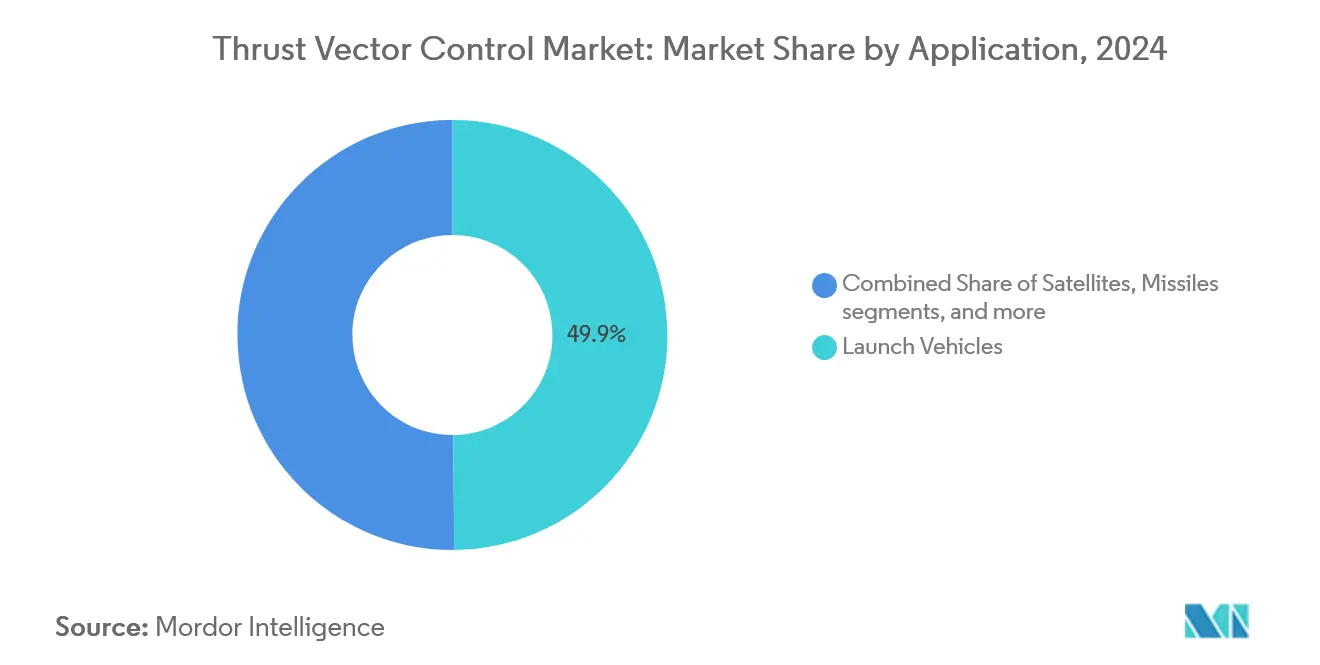
Note: Segment shares of all individual segments available upon report purchase
By End User: Defense keeps the lead, space agencies accelerate
Defense programs generated 65.78% of 2024 revenue through missile upgrades and hypersonic glide-body work. Space-agency procurement, led by ISRO, JAXA, and NASA’s CLD initiative, is forecasted to grow at 10.07% CAGR as government customers adopt a commercial mission cadence.
Agencies are aligning qualification standards with defense grade to enable dual use, allowing a single actuator line to serve lunar landers and missile interceptors. While this convergence lets suppliers amortize R&D across programs, export-control divergence still complicates tri-national joint ventures, particularly on vectoring software judged “militarily significant.”
By Technology: Gimbal systems dominate, rotating nozzles rise
Gimbal nozzles accounted for 42.65% of 2024 revenue—a testament to decades-long heritage from the space shuttle to ground-based midcourse defense. Rotating nozzles, however, are expected to expand at 11.87% CAGR as hypersonic glide vehicles need extreme-angle steering at low dynamic pressure.
Flex-nozzle technology remains the solution of choice where packaging constraints preclude heavy gimbals, particularly on upper stages and small interceptors. Electric-thruster vectoring now finds traction in satellite collision-avoidance kits, marrying millinewton-level throttling with micro-gimbal alignment. Hybrid architectures—mechanical gimbal during dense-air ascent and thruster-based steering in vacuum—offer a pathway to cross-environment optimization.
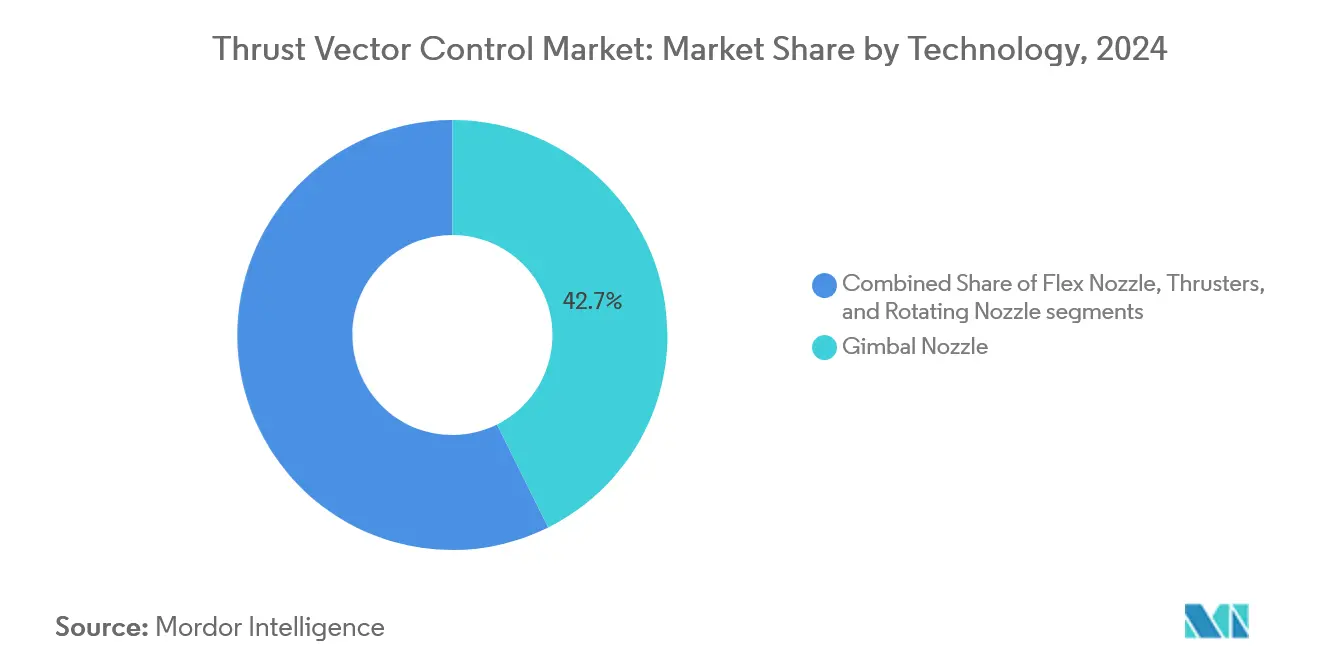
Note: Segment shares of all individual segments available upon report purchase
Geography Analysis
North America generated 47.30% of the global revenue in 2024, underpinned by USD 849.8 billion in US defense allocations and SpaceX’s unrivaled launch tempo. Guam’s integrated missile-defense testbed funnels vectoring work to primes such as RTX and Moog, while the October 2024 “Space Rules” reduce licensing friction for Australia, Canada, and the UK. Canada’s MDA and Mexico’s Querétaro aerocluster add niche manufacturing roles, but the United States remains the indisputable regional anchor.
The Asia-Pacific region is set to record a 9.87% CAGR, making it the fastest-growing regional segment of the thrust vector control systems market. India’s INR 13,416 crore (USD 1.56 billion) ISRO allocation funds the Next Generation Launch Vehicle and Venus Orbiter, each demanding refined vectoring capability. Japan’s dual-track strategy combines the JPY 8.7 trillion (USD 60.41 billion) defense budget with a USD 6.4 billion Space Strategy Fund, generating steady demand for dual-use actuators. China, leveraging SAST’s reusable rocket tests and sixth-generation fighter prototypes, prioritizes domestic supply chains to hedge against export-control risks. Australia’s Global Supply Chain program channels Moog and Honeywell know-how into sovereign projects.
Europe retains a balanced growth outlook tied to Ariane 6, Eurofighter radar upgrades, and emerging space-situational-awareness constellations. ESA’s collaborative procurement guidelines spread cost across members but cannot fully offset competitive pressure from the US and Chinese low-cost launch pricing. Russia’s share remains constrained by sanctions, though legacy engine know-how still surfaces through indirect supply chains. Middle East and Africa are embryonic yet promising; Saudi Arabia’s Vision 2030 aerospace offset program and the UAE’s moon-and-Mars ambitions require imported vectoring systems until local capacity matures.
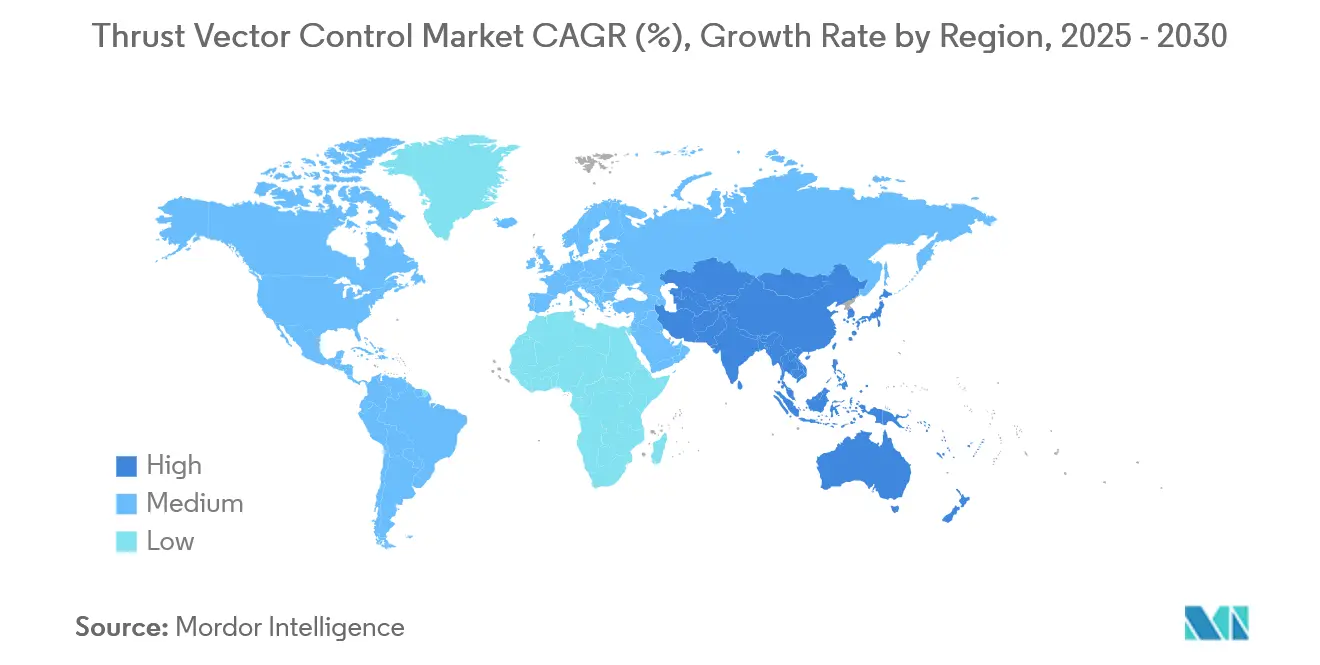
Competitive Landscape
The thrust vector control systems market exhibits moderate concentration. Honeywell, Moog, and RTX collectively leverage decades of qualification data and vertically integrated test infrastructure. Honeywell’s 30-year portfolio covers hydraulic, hybrid, and fully electric gimbals, allowing the firm to capture replacement cycles tied to the hydraulic-to-electric shift. RTX controls critical guidance firmware that locks in long-term software-update contracts through its Collins and Raytheon units.
Woodward’s acquisition of Safran’s electromechanical actuation business deepens Airbus A350 IP ownership and accelerates migration into space platforms. White-space disruptors target micro-launcher and satellite-thruster niches, offering additive-manufactured nozzles with integrated cooling channels that cut lead time by 70%. Their challenge is padding balance sheets to finance certification burn-down.
Intellectual-property intensity rises steadily. EPO’s data show 9% annual growth in propulsion filings, with electric-propulsion claims now outpacing chemical ones. Suppliers wrap hardware with digital-twin diagnostics and usage-based maintenance plans, converting one-off ship-set sales into multi-year service revenues that cushion cyclicality.
Thrust Vector Control Industry Leaders
-
Honeywell International Inc.
-
Moog Inc.
-
RTX Corporation
-
Woodward, Inc.
-
BAE Systems plc
- *Disclaimer: Major Players sorted in no particular order
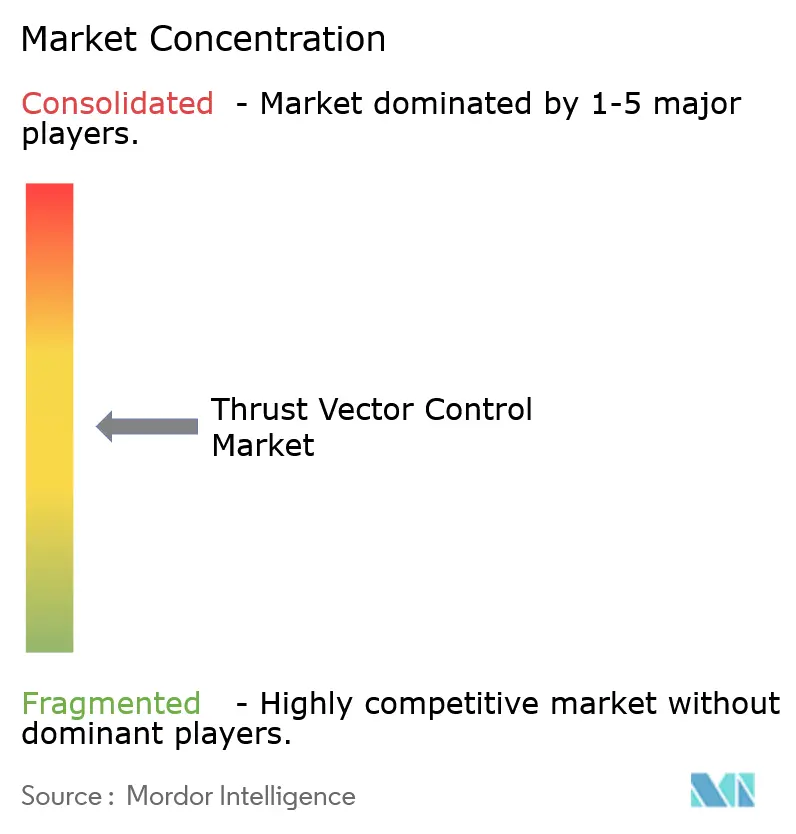


Recent Industry Developments
- June 2025: SpaceX secured a USD 81.6 million contract to launch the U.S. military’s WSF-M2 weather-monitoring satellite in 2027, under the NSSL Phase 3 Lane 1 program. The mission, USSF-178, includes BLAZE-2 as a secondary payload and features trust vector control technology.
- April 2025: Blue Origin secured a critical contract as a heavy-lift provider under the National Security Space Launch (NSSL) Phase 3 Lane 2, supporting the Department of Defense and National Reconnaissance Office. This award enhances competition, ensures reliable access to space, and incorporates trust vector control for mission assurance.
Global Thrust Vector Control Market Report Scope
Thrust vector control (TVC), also known as thrust vectoring, is the ability of a fighter aircraft, rocket, or another launch vehicle to manipulate the direction of the thrust from its engine or motors to control the attitude or angular velocity of the vehicle.
The thrust vector control market is segmented based on application, end user, and geography. By application, the market is segmented into launch vehicles, satellites, missiles, and fighter aircraft. By end user, the market is divided into space agencies and defense bodies. By geography, the market is segmented into North America, Europe, Asia Pacific, Latin America, and the Middle East and Africa.
The market sizing and forecasts have been provided in value (USD Billion) for all the above segments.
| Launch Vehicles |
| Satellites |
| Missiles |
| Combat Aircraft |
| Defense |
| Space Agencies |
| Gimbal Nozzle |
| Flex Nozzle |
| Thrusters |
| Rotating Nozzle |
| North America | United States | |
| Canada | ||
| Mexico | ||
| Europe | Germany | |
| United Kingdom | ||
| France | ||
| Russia | ||
| Rest of Europe | ||
| Asia-Pacific | China | |
| Japan | ||
| India | ||
| Australia | ||
| Rest of Asia-Pacific | ||
| South America | Brazil | |
| Rest of South America | ||
| Middle East and Africa | Middle East | United Arab Emirates |
| Saudi Arabia | ||
| Rest of Middle East | ||
| Africa | South Africa | |
| Rest of Africa | ||
| By Application | Launch Vehicles | ||
| Satellites | |||
| Missiles | |||
| Combat Aircraft | |||
| By End User | Defense | ||
| Space Agencies | |||
| By Technology | Gimbal Nozzle | ||
| Flex Nozzle | |||
| Thrusters | |||
| Rotating Nozzle | |||
| By Geography | North America | United States | |
| Canada | |||
| Mexico | |||
| Europe | Germany | ||
| United Kingdom | |||
| France | |||
| Russia | |||
| Rest of Europe | |||
| Asia-Pacific | China | ||
| Japan | |||
| India | |||
| Australia | |||
| Rest of Asia-Pacific | |||
| South America | Brazil | ||
| Rest of South America | |||
| Middle East and Africa | Middle East | United Arab Emirates | |
| Saudi Arabia | |||
| Rest of Middle East | |||
| Africa | South Africa | ||
| Rest of Africa | |||


Key Questions Answered in the Report
What is the current and forecasted size of the thrust vector control market?
The market is valued at USD 14.39 billion in 2025 and is forecasted to reach USD 22.06 billion by 2030, reflecting an 8.92% CAGR.
Which application segment held the largest revenue share in 2024, and what was that share?
Launch vehicles dominated with 49.87% of the thrust vector control systems market share in 2024.
How are export-control changes influencing suppliers?
US reforms ease licensing for space-tourism payloads but tighten rules on hypersonic vectoring, lengthening compliance cycles for cross-border joint ventures.
Which region offers the greatest incremental opportunity?
Asia-Pacific, driven by India’s and Japan’s civil-space budgets and China’s indigenous fighter and launcher programs, is set to grow nearly 10% annually through 2030.
Why is the shift to all-electric actuators significant?
Electromechanical units eliminate hydraulic fluid, reduce mass, and incorporate health-monitoring electronics, improving reliability and lowering life-cycle costs despite higher upfront qualification spending.
Page last updated on:
